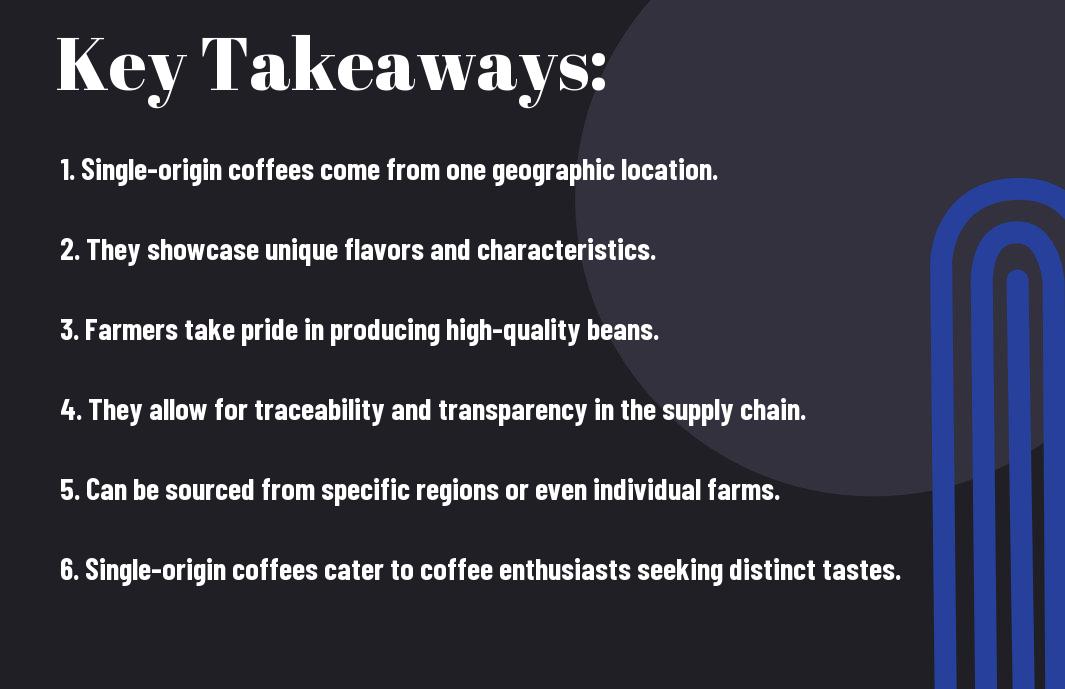There’s a movement in the coffee world that champions single-origin coffees, but what exactly are they? Single-origin coffees come from a specific region, estate, or even a single farm, allowing coffee lovers to taste the unique flavors and characteristics of that particular area. In a world of mass-produced blends, single-origin coffees offer a glimpse into the terroir of coffee, much like how wine connoisseurs appreciate the nuances of different vineyards. Let’s probe the world of single-origin coffees and discover what makes them so special.

Key Takeaways:
- Single-origin coffees come from a specific geographic region, offering unique flavors and characteristics due to factors like climate, soil, and elevation.
- These coffees are highly sought after by coffee enthusiasts looking to experience the diverse and nuanced flavor profiles that different regions have to offer.
- Single-origin coffees provide transparency in the supply chain, allowing consumers to trace the coffee back to its exact origin.
- By supporting single-origin coffees, you are also supporting the local farmers and communities where the coffee is grown, promoting sustainability and ethical practices in the coffee industry.
- While single-origin coffees may come at a higher price point than blends, the unique flavors and quality justify the cost for those who appreciate the art and science of great coffee.

Defining Single-Origin Coffees
The Concept of Single-Origin
For coffee connoisseurs and enthusiasts, the term “single-origin” refers to coffee beans that come from a specific region, farm, or country. These coffees are prized for their unique flavors and characteristics that are a direct result of their distinct growing conditions, such as altitude, soil composition, and climate. By knowing the exact origin of the beans, consumers can trace the coffee back to its roots and appreciate the nuances that make it special.
How it Differs from Blends
With single-origin coffees, the focus is on showcasing the pure essence of a particular coffee bean. In contrast, coffee blends are created by mixing beans from different regions to achieve a specific flavor profile or balance. While blends can offer complexity and consistency, single-origin coffees allow for a more authentic and transparent coffee experience, highlighting the unique flavors and terroir of a specific region.
Differs from blends, where the goal is often to create a well-rounded and balanced flavor, single-origin coffees offer a more straightforward and unadulterated taste experience. Each sip tells a story of where the coffee was grown, allowing consumers to appreciate the rich diversity of flavors that can be found within the world of coffee.

The Benefits of Single-Origin Coffees
Unique Flavor Profiles
With single-origin coffees, you can experience a wide range of unique and distinct flavor profiles that are specific to the region where the coffee beans were grown. Each cup tells a story of the soil, climate, and elevation of the farm it originated from, offering a rich and diverse tasting experience for coffee enthusiasts.
Transparency and Traceability
Benefits of single-origin coffees include the transparency and traceability they offer. By knowing exactly where your coffee beans come from, you can trust the quality and authenticity of the product. This direct relationship between the consumer and the farmer promotes ethical practices and sustainability in the coffee industry.
To fully appreciate the benefits of transparency and traceability in single-origin coffees, consumers can look for certifications like Fair Trade or Direct Trade, which ensure that farmers are paid fairly and work under good conditions. By choosing single-origin coffees with these certifications, you can support responsible and ethical practices in the coffee supply chain.
Supporting Small-Scale Farmers
For small-scale farmers, selling single-origin coffees provides a platform to showcase their unique products and craftsmanship. By purchasing single-origin coffees, you are directly supporting these farmers and their communities, empowering them to continue producing high-quality coffee sustainably.
Coffees sourced from small-scale farmers often come with a story behind them, adding an extra layer of richness to your coffee-drinking experience. With each cup of single-origin coffee you savor, you are not just enjoying a delicious brew but also making a positive impact on the livelihoods of these dedicated farmers.
The Production Process
Many factors come into play during the production process of single-origin coffees, from the harvesting and processing methods to the role of terroir and the meticulous roasting and quality control practices.
Harvesting and Processing Methods
Harvesting for single-origin coffees is typically done by hand to ensure only the ripest cherries are selected. This labor-intensive process results in higher quality beans and allows for better sorting. The processing methods vary depending on the region and can include natural processing, washed processing, or honey processing.
The Role of Terroir
One of the key factors that sets single-origin coffees apart is the concept of terroir, which refers to the environmental factors that influence the coffee beans’ characteristics. These factors include the altitude at which the coffee is grown, the climate, soil composition, and even the surrounding flora. The unique terroir of each region imparts distinct flavors and aromas to the coffee beans.
It is this sense of place that gives single-origin coffees their individuality and allows coffee enthusiasts to experience the nuances of different coffee-growing regions. Whether it’s the citrusy notes of a coffee from Ethiopia or the chocolatey undertones of a coffee from Colombia, terroir plays a significant role in shaping the flavor profile of single-origin coffees.
Roasting and Quality Control
Controlled roasting is a crucial step in the production process of single-origin coffees as it brings out the unique flavors of the beans while maintaining their quality. Roasters carefully monitor factors such as temperature, air flow, and roasting time to ensure a perfect roast. Quality control measures are also implemented to ensure consistency and excellence in every batch.
The art of roasting single-origin coffees lies in highlighting the nuances of the beans’ flavors without overpowering them. Roasters strive to bring out the best in each batch, showcasing the distinct characteristics of the coffee beans from a particular region.
Exploring Single-Origin Coffee Regions
Latin American Coffees
Your journey into the world of single-origin coffees can begin with Latin American coffees. Countries like Brazil, Colombia, Costa Rica, and Guatemala are well-known for producing high-quality beans with unique flavor profiles. Brazilian coffees often have nutty and chocolatey notes, while Colombian coffees are prized for their fruity and floral aromas. Costa Rican coffees are known for their bright acidity, and Guatemalan coffees often exhibit a combination of chocolate and fruit flavors.
African Coffees
For a truly exotic coffee experience, explore African coffees from countries like Ethiopia, Kenya, and Rwanda. Ethiopian coffees are celebrated for their complex and varied flavor profiles, often featuring floral, fruity, and spicy notes. Kenyan coffees are known for their bright acidity and berry undertones, while Rwandan coffees offer a balance of sweetness and acidity, with hints of citrus and caramel.
African coffees are often processed using unique methods like natural or washed processing, which can further enhance their distinct flavors. The terroir, altitude, and climate of African coffee regions also play a significant role in shaping the character of the beans, making each cup a truly special experience.
Asian Coffees
American An exploration of single-origin coffees would not be complete without delving into the world of Asian coffees, particularly those from countries like Indonesia, Vietnam, and India. Indonesian coffees, such as Sumatran and Java beans, are known for their full-bodied and earthy flavors, with hints of spice and herbs. Vietnamese coffees often have a unique sweetness due to their traditional method of incorporating condensed milk.
Coffees from India, such as those from the regions of Mysore and Malabar, offer a distinct profile with notes of cocoa, spices, and nuts. These coffees are often grown in shade-grown plantations, which contribute to their nuanced flavors and sustainable practices.

The Impact of Single-Origin Coffees on the Industry
Changing Consumer Preferences
All around the world, there is a noticeable shift in consumer preferences when it comes to their daily cup of coffee. More and more coffee lovers are becoming interested in the origins of their beans, seeking out single-origin coffees that offer a unique and distinct flavor profile. This growing demand for transparency and quality has put pressure on coffee producers and roasters to source ethically and sustainably while also highlighting the diverse flavors that different regions have to offer.
Shifting Business Models
On the business side of things, the rise of single-origin coffees has prompted a shift in traditional business models within the coffee industry. Roasters are now focusing on building direct relationships with farmers to ensure a consistent and high-quality supply of beans. This approach not only benefits the farmers by providing them with better financial stability but also allows roasters to distinguish themselves in a crowded market by offering exclusive and carefully curated coffee selections.
One of the main advantages of this shift towards direct trade relationships is the increased control and understanding that roasters have over the entire coffee production process. By working closely with farmers, roasters can influence the farming practices used, leading to improved environmental and social outcomes.
Environmental and Social Implications
A major impact of the single-origin coffee trend is its potential to drive positive environmental and social change within the industry. By supporting coffee producers who adhere to sustainable farming practices, consumers are not only enjoying high-quality coffee but also contributing to the preservation of ecosystems and the well-being of farming communities.
Preferences for single-origin coffees have also opened up conversations about fair pricing and equitable trade relationships. As consumers become more educated about the origins of their coffee and the challenges faced by producers, there is a growing demand for transparency and fairness in the supply chain. This shift towards ethical sourcing practices has the power to create a more sustainable and equitable coffee industry for all stakeholders involved.
Brewing Single-Origin Coffees
After selecting your favorite single-origin coffee beans, the next step is brewing them to perfection. To truly appreciate the unique flavors and characteristics of single-origin coffees, it’s necessary to use the right brewing methods, equipment, and techniques.
Optimal Brewing Methods
Any coffee enthusiast knows that different brewing methods can bring out varying flavors in your coffee. For single-origin coffees, the pour-over method is highly recommended as it allows you to control the brewing process more precisely, resulting in a clean and flavorful cup. Alternatively, a French press can also be a good choice for highlighting the nuanced flavors of single-origin beans.
Equipment and Techniques
On the equipment front, investing in a quality burr grinder is crucial for brewing single-origin coffees. A burr grinder ensures a consistent grind size, which is necessary for extracting the best flavors from your beans. Additionally, using filtered water at the right temperature and practicing proper brewing techniques, such as blooming the coffee grounds, can further enhance the taste of your single-origin brew.
It is important to note that the equipment and techniques you use can significantly impact the final taste of your single-origin coffee. Investing in a high-quality coffee maker or espresso machine can also be beneficial if you prefer a more hands-off approach to brewing. Experimenting with different brewing methods and techniques will help you find the perfect balance to bring out the best flavors in your single-origin coffees.
Tips for Bringing Out the Best Flavors
It is necessary to pay attention to the brewing ratio when brewing single-origin coffees. A general rule of thumb is to use a ratio of 1:16 (coffee to water) for a balanced and flavorful cup. Grinding your coffee beans just before brewing can also make a significant difference in the freshness and taste of your coffee. Additionally, adjusting the grind size and brewing time according to the specific characteristics of your beans can help you bring out their unique flavors.
- Experiment with different brewing methods to find the one that best suits your single-origin coffee.
- Perceiving the subtle nuances and flavors of single-origin coffees may require some practice and patience, but the reward is a truly exceptional cup of coffee.
Summing up
Considering all points covered in the article “What are single-origin coffees”, it is evident that these coffees offer a unique experience by showcasing the distinct flavors and characteristics of a specific region. By focusing on the origin of the beans, coffee enthusiasts can appreciate the diverse tastes and aromas that come from different terroirs around the world. Whether you’re a casual coffee drinker or a connoisseur, exploring single-origin coffees can open up a whole new world of flavors and appreciation for the art of coffee-making.
FAQ
Q: What are single-origin coffees?
A: Single-origin coffees are coffees that are sourced from a specific geographic region, such as a country, a specific farm, or a particular cooperative. These coffees are prized for their unique flavors and characteristics that are a result of the region’s soil, climate, and altitude.
Q: What sets single-origin coffees apart from blends?
A: Single-origin coffees are known for their distinct flavor profiles that showcase the unique qualities of a particular region. Blends, on the other hand, are a combination of coffees from different regions or even different countries, crafted to achieve a specific flavor profile or consistency.
Q: Why are single-origin coffees becoming increasingly popular?
A: Single-origin coffees have gained popularity among coffee enthusiasts and connoisseurs because they offer a genuine taste of a specific region’s coffee growing practices and terroir. This allows coffee drinkers to explore and appreciate the different flavor profiles that various regions have to offer.
What are the origins of coffee





